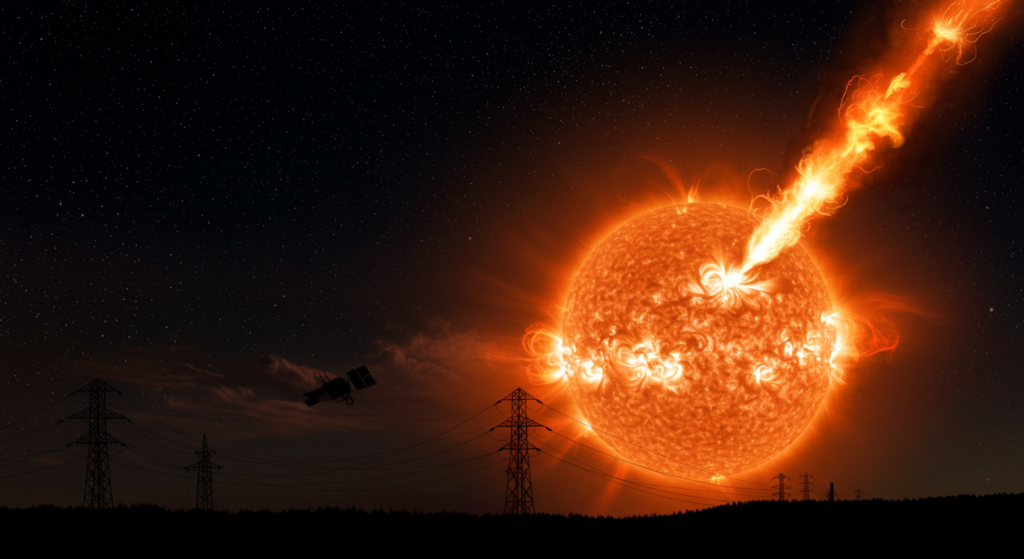The impact of solar flares can be astonishing, especially when considering their effects on Earth and technology. These powerful energy bursts can disrupt various systems that we rely on daily. Understanding these phenomena is crucial for mitigating their potential risks. By grasping the underlying science, we can develop strategies to minimize the impact of these solar events on our daily lives.
This article will explore the various impacts of solar flares on technology, including their effects on communication systems, power grids, and the safety of astronauts in space.
In this article, we will delve into the intricate relationship between solar flares and their effects on our technological systems. We will examine how these solar events can disrupt communication networks, power grids, and even pose risks to astronauts in space. By highlighting the role of organizations like NOAA and NASA in monitoring solar activity, we aim to underscore the importance of preparedness in mitigating the risks associated with solar flares. Understanding these phenomena is not just a scientific endeavor; it is essential for ensuring the safety and reliability of the technology that underpins our daily lives. Join us as we explore the fascinating world of solar flares and their far-reaching implications.
As we journey through the complexities of solar flares and their impact on our technology, you might find yourself wondering just how much these cosmic events influence your everyday life. From the GPS on your phone to the power that lights up your home, solar flares can throw a wrench into the works in ways you might never have considered. But don’t worry—by the end of this article, you’ll not only understand the science behind these solar phenomena but also feel empowered to take steps to safeguard your technology and stay informed. So, grab a cup of coffee, settle in, and let’s uncover the surprising ways the sun can affect us right here on Earth!
Discover the Impact of Solar Flares and Their Threat to Satellites and Astronauts
These intense energy bursts can lead to serious consequences for our daily lives. Solar flares are like the Sun’s way of sending us a cosmic wake-up call. Understanding their impact is essential for safeguarding our technological infrastructure. This knowledge empowers us to take proactive measures to protect our systems and ensure continuity of service.
The X1.1 flare represents one of the most potent types of solar flares. The classification indicates its strength, with ‘X’ denoting its high energy level. Such powerful flares can disrupt radio communications, affecting how we connect and share information. For example, they can interfere with electric power grids, leading to potential blackouts. Such blackouts can have cascading effects on various sectors, highlighting the need for robust contingency plans.
Navigation signals also face risks, which can complicate travel and logistics. Imagine trying to navigate a ship in a storm without a compass; that’s what solar flares can do to our navigation systems.
On the negative side, the dangers extend to satellites and astronauts in space. Astronauts may also face increased radiation exposure during solar events, which poses health risks. It’s a bit like playing a game of dodgeball, but instead of balls, you’re dodging bursts of radiation in space! By collaborating with various stakeholders, they enhance our collective resilience against solar threats.
The Space Weather Prediction Center plays a crucial role in studying solar phenomena. Think of the Space Weather Prediction Center as our cosmic weather forecaster, helping us dress appropriately for solar storms. They analyze the Sun’s behavior and its effects on the Earth’s atmosphere and space environment. By providing watches and warnings, they help us prepare for potential disruptions. This proactive approach is vital for maintaining the safety of our technology and the people who depend on it. Recognizing the effects of solar flares is important for all stakeholders, including individuals and corporations.

What Solar Activity Means for Our Planet’s Future Is Shocking
The impact of solar activity on Earth is closely monitored by organizations like NOAA’s Space Weather Prediction Center (SWPC) and NASA, which provide forecasts and conduct research on the Sun and its effects. These organizations play a vital role in understanding solar phenomena. Their efforts help us prepare for potential disruptions caused by solar flares.
The NOAA’s Space Weather Prediction Center serves as a reliable resource for forecasts, watches, warnings, and alerts related to space weather. This center monitors solar activity closely, providing essential information to help mitigate risks. By staying informed, individuals and organizations can better prepare for the impact of solar flares. This preparation is key to minimizing disruptions and ensuring safety in our increasingly technology-dependent world. In a world where technology is our lifeline, being prepared for solar flares is like having an umbrella on a cloudy day.
NASA also plays a crucial role in monitoring solar activity. They utilize various spacecraft to study the Sun, its atmosphere, and the surrounding space environment. This research includes examining particles and magnetic fields that can affect Earth. Understanding these elements is crucial for predicting solar events and their potential impacts on our planet.
To clarify, understanding the dangers posed by solar flares is essential for protecting satellites and astronauts. The stakes are high, and understanding solar flares is not just for scientists; it’s for everyone who relies on technology.
As We Reflect on the Impact of Solar Flares the Future of Technology and Communication Awaits
Did you know that a single solar flare can disrupt communication systems across the globe? It’s a startling thought, isn’t it? These bursts of energy from the Sun can affect everything from our GPS navigation to the power grid that keeps our homes running. Understanding these solar phenomena isn’t just for scientists; it’s something that impacts all of us in our daily lives. By learning about the science behind solar flares, we can take steps to protect ourselves and our technology from their unpredictable effects.
The consequences of solar flares are more than just technical glitches. Take the X1.1 flare, for example; it reminded us how vulnerable our communication systems can be. Organizations like NOAA and NASA play a vital role in monitoring these solar events, providing us with forecasts and alerts that help us stay one step ahead. Their proactive measures are essential in shielding our technology and infrastructure from potential disruptions, ensuring that we can continue our daily routines with minimal interference.
In wrapping up, it’s clear that keeping an eye on solar flares is crucial for the safety of our technological systems. The X1.1 flare serves as a powerful reminder of the dynamic forces at work in our solar system. By studying the Sun and its effects, we can better equip ourselves for future solar events. This ongoing research is not just about science; it’s about ensuring that we can navigate the challenges posed by solar activity with confidence. So, let’s stay informed and ready, because the more we understand, the better we can protect our technology and our way of life.
Listen to an AI-Generated Podcast of this Blog
Solar Flares: The Cosmic Disruptors of Our Technology
Here’s a fascinating random fact about solar flares. Solar flares are intense energy bursts from the Sun. These powerful flares can disrupt radio communications on Earth. Additionally, they can affect electric power grids, leading to potential blackouts. To put it another way, solar flares can interfere with navigation signals, complicating travel. The X1.1 flare is one of the most powerful types of solar flares. Such flares pose dangers to satellites and astronauts in space. NOAA’s Space Weather Prediction Center provides forecasts and alerts about solar activity. NASA plays a crucial role in monitoring solar activity using spacecraft. They study the Sun, its atmosphere, and the surrounding space environment. Overall, understanding solar flares is essential for protecting our technology and infrastructure.
FAQs
What are solar flares and why should we care about them?
Solar flares are powerful energy bursts from the Sun. As a result, they can disrupt technology on Earth, making them important to monitor and understand.
How do solar flares affect communication systems?
Specifically, solar flares can disrupt radio communications, thereby impacting how we connect and share information.
What is the significance of the X1.1 flare?
The X1.1 flare is a potent solar flare. Consequently, it can cause significant disruptions to technology and electronic systems.
How do solar flares impact electric power grids?
In particular, solar flares can interfere with electric power grids, which may lead to blackouts and service interruptions.
What risks do solar flares pose to navigation signals?
Solar flares can complicate navigation signals, making travel and logistics more challenging.
How do solar flares affect astronauts in space?
Astronauts face increased radiation exposure during solar events, posing health risks to them.
What role does NOAA play in monitoring solar activity?
NOAA provides forecasts, watches, warnings, and alerts related to solar activity and its impacts.
How does NASA contribute to understanding solar flares?
NASA uses spacecraft to study the Sun, its atmosphere, and the surrounding space environment.
Why is it important to understand the impact of solar flares?
Understanding solar flares helps us protect technology and ensure safety in our technology-dependent world.
What can individuals do to prepare for solar flares?
Staying informed about solar activity and understanding its effects can help individuals prepare for disruptions.
ORDER YOUR SEO OPTIMIZED BLOG TODAY
If you’ve landed on this page while searching for SEO marketing — well, that’s the proof right there. You found us through SEO. In fact, we haven’t used social media. We haven’t run paid ads either. Instead, we’ve relied solely on our own articles. So, why not let it work for you too? Go ahead — order your blog with us.
Each one is generated using our custom-built AI prompt system. From there, it’s enhanced further with carefully crafted prompts to improve clarity, structure, and keyword focus.






